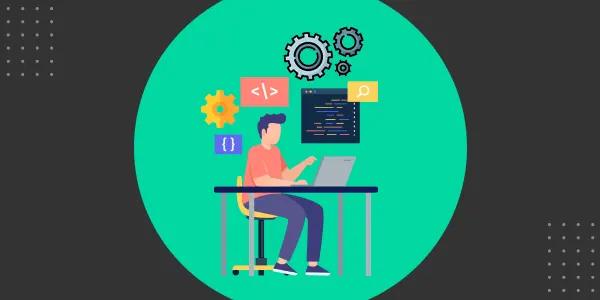With many businesses shifting towards Continuous Delivery (CD) and DevOps frameworks, the need for automated testing has never been stronger. Test automation is important to success with these short Build/Deploy cycles; removing the manual testing limitation is critical to sustaining lowered cycle durations.
The key difficulty in test automation is defining a test script (the result of the analytical testing stage that is utilized to run test cases) in such a way that a machine can understand it for operational reasons. Producing machine-readable programs is essentially what this implies.
Traditional automation systems usually depended on the programming languages to clear test scripts for implementation since their creation. Yet, there is a fundamental issue: most firms rely on test scripts written and described by test analysts. Analysts and testing experts who study system requirements and design test cases based on that expertise. Scripts for exercising such scenarios are frequently documented in natural language and saved in a repository for later human execution.
Qualified automation (QA) engineers or SDETs are typically appointed to rearticulate test programs in coding form. Whether right or not, most businesses consider automation or automated testing as a translation from human-readable to a format that a machine can easily read, rearticulating the test evaluation phase’s conclusion in another form. This method has scope for improvement.
What is low-code programming?
The phrase Low-Code Development is commonly used to refer to process development solutions, software development tools, and low-code application development, among other things. Low-code development solutions provide the foundation for IT users to build apps and workflows. The infrastructure contributes to the abstraction of code beyond instructions, allowing IT experts to configure enterprise applications as well as workflows with minimum hand-coding.
Low-code test automation
Low-Code Test Automation removes that translation step from its past technique. Providing a method for directly defining test scripts in a way that both persons and computers can understand. Low-Code Automated Testing intends to address the underlying problem of organizational knowledge & information by allowing testing experts who are not completely familiar with code & software development to provide test programs in a machine-readable format, so avoiding the secondary translation process.
Low code Qualified automation strategy
The useful plan of validating digital services can help businesses that have begun their paths towards low-code application development in addressing risk and reaping profit. Validation brings together business and IT to work to develop scalable, reliable, and user-friendly solutions. However, it necessitates a thorough grasp of low-code development techniques as well as the capacity to plan to test multi-experience apps.
In this setting, a tailored quality assurance (QA) plan can provide companies with an unrivaled competitive edge, helping them to get a larger share in the market while lowering the risk of failure
A purposeful emphasis on Qualified automation along with the inclusion of specified verification activities in the low code programming lifecycle may appear to be an augmentation of the stated rapid release date of the low code development approach. Organizations looking forward to maximizing ROI through speedy and error-free solution releases may require a Qualified automation automation strategy adapted to their low code programming journey.
- Focus on quality. Validating the business rules applied in low-code systems for functional accuracy, security protocols, and scalability is essential. This distinguishes low-code Qualified automation from typical functional testing.
- Be future-ready by prioritizing quality assurance (QA) on forecasted business requirements and a larger user base concentrated on the company’s goal. Adjusting to technological advancements through the usage of new era software development testing techniques and technologies. Using AI/ML to create a real-time quality engineering approach that is responsive to the agile environment. Responding to client input through accessibility and UX testing methodologies.
- Expand the market swiftly. With multi-facet test automation, hyper-automation may be done by reusing test materials and coordinating test automation across Qualified automation lifecycle phases. This implies that testing cycles are significantly shorter than with functional organizational test automation.

Reinventing the Quality Process in the Age of DevOps
Quality engineering (QE) has typically did not include the tools required to keep up with digital change. Many QE teams struggle with sophisticated, fragile automation frameworks and delayed manual testing, both of which significantly impede DevOps adoption. While development speeds up, QE is left with disjointed or out-of-date practices and toolkits.
Responding to the challenges and possibilities presented by DevOps & digital transformation will necessitate creativity in our quality approach. Most importantly, we must shift our focus away from quality assurance (QA) as a late-stage task and toward quality engineering (QE) methodologies utilized all through the software life cycle. It all starts with thorough, effective test testing, which should commence when the developer is operating on a local branch & persist until a greater consumer experience is shown in production across the entire surface area of the solution – web, mobile, API, email, PDF, or other. It also goes beyond that; you evaluate all quality components, ensuring that you satisfy correct functionality, scalability, efficiency, user experience, and other criteria.
Low-code test automation tools
With low-code, any job, from traditional testers to programmers, automation engineers, project owners, and customer support, can do effective testing. It is impossible to expect all of these jobs to have specific programming skills, therefore, low-code tools help to democratization quality engineering by allowing anybody to participate in creating tests, upgrading tests, and getting insight from results.
Low-Code automated testing has been around for a long time, but it has lately seen a renaissance. This can be attributed in part to the widespread use of Open Source libraries like Selenium and Appium. The implementation ‘engines,’ which were once the valued intellectual property of conventional tool providers, are now free for anybody to construct abstraction layers on. Updates in user interface and visualization technologies have enabled innovative solutions to emerge outside of the conventional vendor market.
The same core script-to-code translation process applies to these open-source tools, but more severely because they often lack any type of UI.
Final Words
Low-code testing is quickly becoming an integral part of testing and should be included in the toolkit of every product team. It allows less technical users to become more active in the continuous deployment lifecycle, unlocking a quality culture across the company. While other types of testing, such as unit and integration testing, have a lot of value, they are typically restricted by the number of qualified engineers on hand and the time required to conduct end-to-end testing.
Instilling a shift-left culture in the testing method enables successful low-code testing and allows all to accept responsibility for quality assurance with little risk.

Get DevOps Certification & Enhance Your Career Prospects
Enroll in Cognixia’s DevOps Training to advance your career. Take a step to improve your employment potential and future opportunities. Register for our DevOps certification course, which provides you with hands-on, collaborative, and instructor-led training sessions. Cognixia is here to give you an exceptional online learning experience, to help you enhance your expertise through intuitive training, and to add significant value to your level of skills and knowledge in increasingly competitive markets. Individuals and businesses alike can benefit from Cognixia’s online courses.
Regardless of experience in IT technology and procedures, the DevOps Plus course delivers a thorough introduction to the discipline, covering all important principles, approaches, and tools. Beginning with a basic introduction to DevOps, it covers the fundamentals of virtualization, its advantages, and the several virtualization technologies crucial in understanding and implementing the DevOps culture.
DevOps tools like Vagrant, Containerization, VCS, and Docker, as well as Configuration Management tools like Chef, Puppet, SaltStack, and Ansible, will be covered.
This DevOps course covers intermediate to advanced aspects. Get certified in DevOps and become acquainted with concepts such as the open-source monitoring tool Nagios, including its plugins, and the usage as a graphical user interface. The Advanced DevOps fundamentals are discussed in full, as well as Docker container clustering leveraging Docker Swarm & Kubernetes in the CI/CD Pipeline Automation.
Our online DevOps training covers the following concepts –
- Introduction to DevOps
- GIT: Version Control
- Maven
- Docker – Containers
- Puppet for configuration management
- Ansible
- Nagios: Monitoring
- Jenkins – Continuous Integration
- Docker Container Clustering using Docker Swarm
- Docker Container Clustering using Kubernetes
- Advanced DevOps (CI/CD Pipeline Automation)
Prerequisites
This course requires just a basic grasp of programming & software development. These requirements are helpful but not compulsory because this all-inclusive training is aimed at newcomers and experienced professionals.

